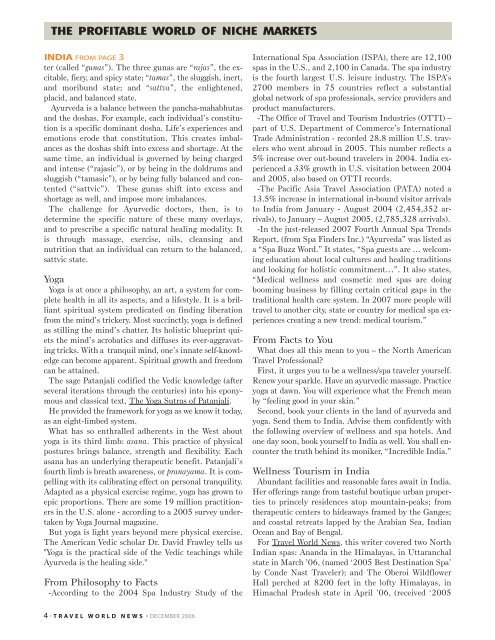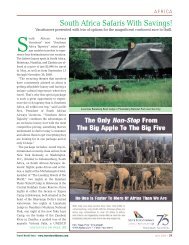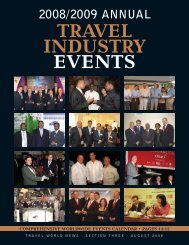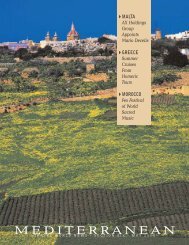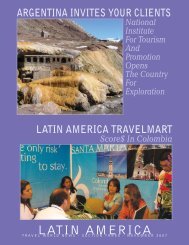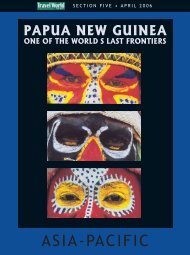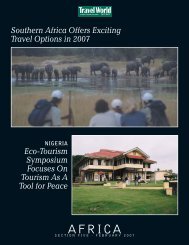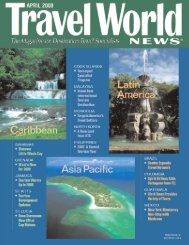4-1206-Niche Markets.qxp - Travel World News
4-1206-Niche Markets.qxp - Travel World News
4-1206-Niche Markets.qxp - Travel World News
You also want an ePaper? Increase the reach of your titles
YUMPU automatically turns print PDFs into web optimized ePapers that Google loves.
THE PROFITABLE WORLD OF NICHE MARKETS<br />
INDIA FROM PAGE 3<br />
ter (called “gunas”). The three gunas are “rajas”, the excitable,<br />
fiery, and spicy state; “tamas”, the sluggish, inert,<br />
and moribund state; and “sattva”, the enlightened,<br />
placid, and balanced state.<br />
Ayurveda is a balance between the pancha-mahabhutas<br />
and the doshas. For example, each individual’s constitution<br />
is a specific dominant dosha. Life’s experiences and<br />
emotions erode that constitution. This creates imbalances<br />
as the doshas shift into excess and shortage. At the<br />
same time, an individual is governed by being charged<br />
and intense (“rajasic”), or by being in the doldrums and<br />
sluggish (“tamasic”), or by being fully balanced and contented<br />
(“sattvic”). These gunas shift into excess and<br />
shortage as well, and impose more imbalances.<br />
The challenge for Ayurvedic doctors, then, is to<br />
determine the specific nature of these many overlays,<br />
and to prescribe a specific natural healing modality. It<br />
is through massage, exercise, oils, cleansing and<br />
nutrition that an individual can return to the balanced,<br />
sattvic state.<br />
Yoga<br />
Yoga is at once a philosophy, an art, a system for complete<br />
health in all its aspects, and a lifestyle. It is a brilliant<br />
spiritual system predicated on finding liberation<br />
from the mind’s trickery. Most succinctly, yoga is defined<br />
as stilling the mind’s chatter. Its holistic blueprint quiets<br />
the mind’s acrobatics and diffuses its ever-aggravating<br />
tricks. With a tranquil mind, one’s innate self-knowledge<br />
can become apparent. Spiritual growth and freedom<br />
can be attained.<br />
The sage Patanjali codified the Vedic knowledge (after<br />
several iterations through the centuries) into his eponymous<br />
and classical text, The Yoga Sutras of Patanjali.<br />
He provided the framework for yoga as we know it today,<br />
as an eight-limbed system.<br />
What has so enthralled adherents in the West about<br />
yoga is its third limb: asana. This practice of physical<br />
postures brings balance, strength and flexibility. Each<br />
asana has an underlying therapeutic benefit. Patanjali’s<br />
fourth limb is breath awareness, or pranayama. It is compelling<br />
with its calibrating effect on personal tranquility.<br />
Adapted as a physical exercise regime, yoga has grown to<br />
epic proportions. There are some 19 million practitioners<br />
in the U.S. alone - according to a 2005 survey undertaken<br />
by Yoga Journal magazine.<br />
But yoga is light years beyond mere physical exercise.<br />
The American Vedic scholar Dr. David Frawley tells us<br />
"Yoga is the practical side of the Vedic teachings while<br />
Ayurveda is the healing side."<br />
From Philosophy to Facts<br />
-According to the 2004 Spa Industry Study of the<br />
International Spa Association (ISPA), there are 12,100<br />
spas in the U.S., and 2,100 in Canada. The spa industry<br />
is the fourth largest U.S. leisure industry. The ISPA’s<br />
2700 members in 75 countries reflect a substantial<br />
global network of spa professionals, service providers and<br />
product manufacturers.<br />
-The Office of <strong>Travel</strong> and Tourism Industries (OTTI) –<br />
part of U.S. Department of Commerce’s International<br />
Trade Administration - recorded 28.8 million U.S. travelers<br />
who went abroad in 2005. This number reflects a<br />
5% increase over out-bound travelers in 2004. India experienced<br />
a 33% growth in U.S. visitation between 2004<br />
and 2005, also based on OTTI records.<br />
-The Pacific Asia <strong>Travel</strong> Association (PATA) noted a<br />
13.5% increase in international in-bound visitor arrivals<br />
to India from January - August 2004 (2,454,352 arrivals),<br />
to January – August 2005, (2,785,328 arrivals).<br />
-In the just-released 2007 Fourth Annual Spa Trends<br />
Report, (from Spa Finders Inc.) “Ayurveda” was listed as<br />
a “Spa Buzz Word.” It states, “Spa guests are … welcoming<br />
education about local cultures and healing traditions<br />
and looking for holistic commitment…”. It also states,<br />
“Medical wellness and cosmetic med spas are doing<br />
booming business by filling certain critical gaps in the<br />
traditional health care system. In 2007 more people will<br />
travel to another city, state or country for medical spa experiences<br />
creating a new trend: medical tourism.”<br />
From Facts to You<br />
What does all this mean to you – the North American<br />
<strong>Travel</strong> Professional?<br />
First, it urges you to be a wellness/spa traveler yourself.<br />
Renew your sparkle. Have an ayurvedic massage. Practice<br />
yoga at dawn. You will experience what the French mean<br />
by “feeling good in your skin.”<br />
Second, book your clients in the land of ayurveda and<br />
yoga. Send them to India. Advise them confidently with<br />
the following overview of wellness and spa hotels. And<br />
one day soon, book yourself to India as well. You shall encounter<br />
the truth behind its moniker, “Incredible India.”<br />
Wellness Tourism in India<br />
Abundant facilities and reasonable fares await in India.<br />
Her offerings range from tasteful boutique urban properties<br />
to princely residences atop mountain-peaks; from<br />
therapeutic centers to hideaways framed by the Ganges;<br />
and coastal retreats lapped by the Arabian Sea, Indian<br />
Ocean and Bay of Bengal.<br />
For <strong>Travel</strong> <strong>World</strong> <strong>News</strong>, this writer covered two North<br />
Indian spas: Ananda in the Himalayas, in Uttaranchal<br />
state in March ’06, (named ‘2005 Best Destination Spa’<br />
by Conde Nast <strong>Travel</strong>er); and The Oberoi Wildflower<br />
Hall perched at 8200 feet in the lofty Himalayas, in<br />
Himachal Pradesh state in April ’06, (received ‘2005<br />
4 • TRAVEL WORLD NEWS • DECEMBER 2006


